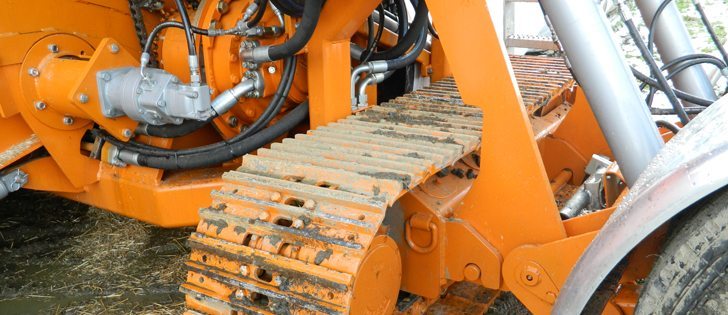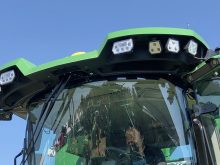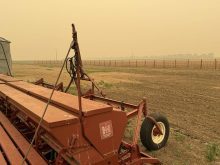Silager | Hydraulic control can double the torque to create better compaction
The all-new Track-Pack silage bagger stuffs a full 20-foot truckload of forage into the big, white bag every 60 to 90 seconds.
That kind of hay volume means a farm’s operations manager needs to be well organized and have a lot of trucks to keep the bagging machine running at peak efficiency, says Mike Koskela. He was an engineer with Ag-Bag Forage Solutions for 20 years before setting up his own company, PacBag.
“To keep any of these high volume baggers running efficiently, you need a full truck waiting to back up to the feed table the instant an empty truck pulls out,” said Koskela, who initiated the concept of a steel tracked bagger and did the design and engineering on the Track-Pack system.
Read Also

Saskatchewan puts crown land auction on hold
Auctions of Saskatchewan crown lease land are once again on hold.
“The machine takes the feed in and packs it into the bag just about as fast as you can unload a truck. Corn comes in easy. If you’re running hard in corn, guys will sometimes have two or even three choppers in the field and as many as 25 trucks all running at the same time.
“I spent 20 years in the field, working directly with the people who run the machines. They always have the best ideas …
“I think we’ve eliminated the problems and the design flaws that impede the flow of material into the bag. And I’ve incorporated the new ideas people wanted to see.”
He studied every silage bagger on the market before sitting down at the drafting table and selected the best technologies that would not create patent issues later on.
He said Track-Pack uses the same basic concept as the Ag-Bag, Versa and other bagger brands. There’s a feed table, rotor and tunnel, but the main difference is that Track-Pack uses hydrostatic drive to power the rotor, creating more torque at the rotor.
“Our diesel doesn’t have as much power as some of the other machines, but the hydrostatic drive makes our horsepower do more work. We can apply way more torque to the rotor and that’s what gives us better packing. In fact, we have more torque on the rotor than the biggest machines on the market.”
He said the Caterpillar C9 engine runs at the same r.p.m. as other machines. When it starts to load and reach full horsepower, the hydraulic control backs off on the oil flow and increases the pressure.
Koskela said it’s basic hydraulic engineering. The rotor slows so hydraulic pressure is increased.
“We can double the torque at the rotor with hydraulics. These are pressure compensated pumps, so we can vary the flow as we want,” he said.
“Once the engine is running at 375 horsepower, if it slows down by 50 r.p.m., the pumps automatically back off. They reduce the flow and increase the pressure. Horsepower remains steady at 375, but torque at the rotor goes up.”
Instrumentation in the cab gives the operator continuous readouts on all mechanical, hydraulic and engine functions.
However, the data does more than just keep the operator informed. The computer co-ordinates the information and feeds it into the braking system.
The use of steel tracks instead of round rubber tires is the other big difference in the Track-Pack bagger. Koskela said the brakes are applied to the steel tracks, thus regulating the crawl speed of the packer.
“We use steel tracks for traction rather than messing with anchors and cables and backstops. The brakes control the creep so we get maximum packing in the bag.
“With the weight of the machine and the grip of the tracks, we can pack to the same density or higher density compared to other baggers. And we do this without any cables or anchors inside or outside the bag. There’s no slippage, even when we’re working in mud or on wet grass.”
Koskela concedes there is slippage when operating on concrete or asphalt, in which case there are rubber pads that bolt to the steel tracks.
With such a wide selection of rubber tracks available, why did Koskela opt for a steel track system?
“For one thing, steel tracks grab the ground better than rubber tracks. They have a better load bearing capacity and they last longer than rubber tracks.”
The Track-Pack is exclusively a PacBag product from the undercarriage upward, but the undercarriage and hydrostatic drive are from a LinkBelt 130 excavator.
Koskela said LinkBelt gets thousands of hours on its undercarriages before they need a rebuild. Drives on an excavator work much harder than they possibly could on a bagger.
He said a bagger does a slow 500 feet at a time, then moves over a few feet and does another slow 500 feet in a straight line. It’s easy on the drive system.
“We use the track drive and the brakes to get our pressure against the bag. The tracks are holding it from moving away from the bag until it gets the right amount of pack you want,” he said.
“When it reaches the right amount, it gradually releases some of the pressure so the bagger moves forward. It never really comes to a complete stop. It’s a continuous slow movement so your silage compaction is uniform through the whole 500 feet.”
Koskela said the Track-Pack will fill a 500-foot bag in about the same time as any other bagger on the market.
“It might be a little faster in some situations, but the main advantage is that you have better compaction and more uniform compaction.”
He said compaction performance in silage baggers is judged in tons per foot. For example, a truck with 20,000 pounds dumps onto the feed table. The operator runs the load through the machine and into the bagger and then measures how many feet the machine has traveled.
The silage is highly compact if the 10-ton load moves the machine only a small distance. It’s dense, which is a good thing. If the machine moves a long distance, it means the machine was not able to create a dense pack.
The frame is narrower than other baggers to allow for closely laid bags. The tunnel has been designed to make it easier to hang the bag.
The cab is mounted on the left side of the machine for a better view of the feed table. There are two computer screens in the cab along with two joysticks and two foot pedals.
The Track-Pack has a transport axle with air ride suspension and semi trailer wheels and tires for highway transit and when moving from yard to yard. It’s jacked into transport position hydraulically. The other end of the machine is a fifth wheel hitch.
Koskela said it’s fairly quick to tear down, move and set up again at another location. It hooks to any highway tractor so there’s no need for a lowboy trailer.
The 12-foot Track-Pack carries a list price of $390,000. A 14-foot unit is available and a 10-foot is planned.
The PacBag company is owned by Koskela’s family in Oregon and Bryan Arthur’s family in British Columbia, owners of Pacific Forage Bag Supply.
For more information, call 855-472-2224 or visit www.pacbag.com.


















